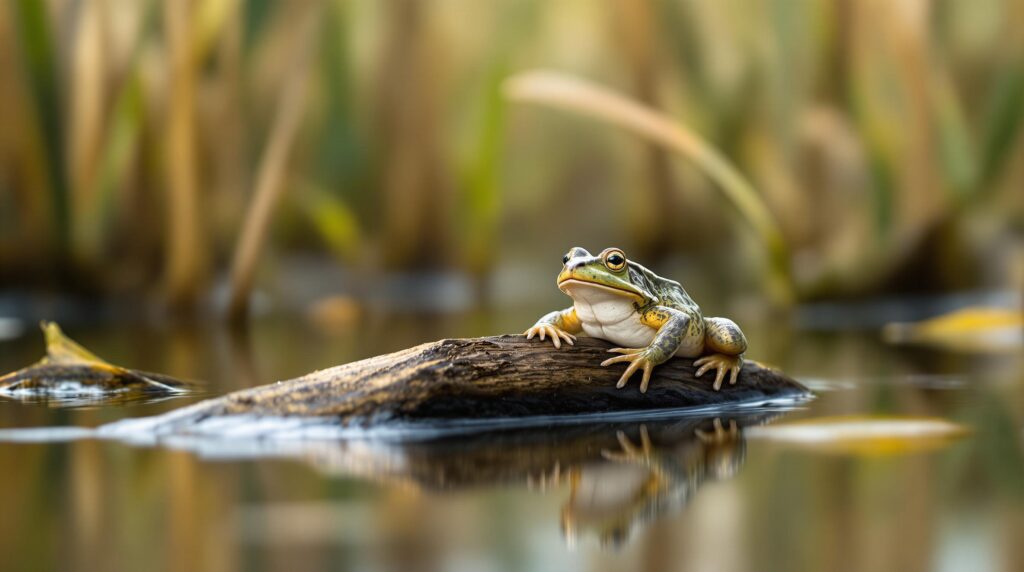Patoka Lake Nature Center is highlighting local amphibians through a program that aims to teach participants about frogs commonly found in nearby wetlands. Although full details of the March 28 session are unavailable, past events have guided visitors through habitats where they can learn to distinguish frogs by their calls and observe egg masses in shallow ponds. Programs like these often draw interest from families eager to understand regional species.
Conservation efforts in the region center on species such as crawfish frogs and wood frogs, two types of amphibians that rely on intact wetland environments. A statewide effort spearheaded by Indiana DNR herpetologists includes ongoing research to determine the distribution and health of amphibian populations. Indiana is home to 41 different species, according to a state overview, and several statewide initiatives continue to track habitat quality.
The DNR Herpetology Program indicates that crawfish frog recovery projects began in 2024, when egg masses were transported from southwestern Indiana to Angel Mounds State Historic Site. After these masses hatched into tadpoles, researchers confirmed that young frogs successfully transformed by midsummer. That milestone reinforced hopes that relocating egg clusters may restore breeding populations in places where they previously died out. Details on this process are also available through this official overview.
Patoka Lake, known for scenic reservoir views and wildlife sightings, is expected to resume kayak tours on April 12 along local waterways. Painted turtles are frequently spotted basking during these tours, while frogs take advantage of seasonal rains to breed in the area. Organizers recommend verifying the activities listed on the posted calendar in case weather patterns shift amphibian appearances.
Many visitors to southern Indiana are drawn by the springtime spectacle of spotted salamanders and chorus frogs emerging to mate in vernal pools. These temporary water bodies form when rainfall accumulates in forested depressions or low-lying fields. According to nature center representatives, salamanders remain underground for most of the year, surfacing briefly to join frogs that share the same transient breeding grounds.
Meanwhile, seasonal programs at Patoka Lake often highlight how amphibians contribute to local biodiversity. Engaging explorations into wetland habitats can help visitors recognize the calls of various frog species, including chorus frogs. Officials advise potential attendees to contact the park office for real-time updates on each event, as unpredictable climate variations may shift peak breeding windows for amphibians.
Beyond scheduled tours, outdoor properties can augment their offerings with guided walks, egg mass identification practice, and interpretive signage aimed at promoting amphibian conservation. Properties can also apply widely accepted best practices such as collaborating with local experts to develop guided excursions focusing on frog calls and wetland ecology, often timed to coincide with peak breeding periods. Interpretive signage near ponds can highlight how amphibians help control insect populations, while basic wildlife awareness training for staff empowers them to address visitor questions and reinforce conservation values.
Additional enhancements to these nature-based programs often involve showing how amphibians maintain ecological balance. By positioning signage that underscores the importance of local species, campgrounds or resorts can encourage respectful interaction with wetlands and ponds. Many visitors benefit from understanding that frogs serve as indicators of environmental health, which can heighten appreciation for responsible stewardship.
Eco-friendly site design also plays a part in sustaining amphibians by preserving critical wetland zones, minimizing nighttime light disruption, and keeping runoff in check. Boardwalks or marked paths reduce accidental habitat damage, while low-impact lighting helps nocturnal species move and feed. Operators can further support amphibian nesting areas by integrating landscaping and water management designs that maintain or create youthful wetland zones, offering guests a chance to observe these creatures responsibly.
With vernal pools and shallow backwaters crucial to amphibian lifecycles, preserving temporary wetlands has become a regional priority. In some areas, effective stewardship of these habitats not only bolsters crawfish frogs but benefits multiple species across the region. By maintaining the quality of influential breeding grounds, outdoor venues build on themes introduced at Patoka Lake, inspiring a greater appreciation of native wildlife.
It is often observed that well-instructed guests are likelier to value local ecosystems and return for future programs. Through adult and family-friendly activities, the lake’s nature center underscores the dynamic role amphibians play in sustaining forests, wetlands, and human experiences alike. Each successful spawn season helps ensure these creatures remain a vibrant part of the area’s identity.
Organizers of special events at Patoka Lake encourage visitors to check daily operations when planning a trip. The calendar at this online schedule lists upcoming programs where enthusiasts can learn more about local frogs, salamanders, and other wildlife. As new details emerge about future amphibian tours, the nature center aims to engage a broader audience in safeguarding habitats for generations to come.








